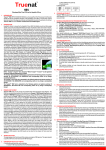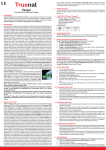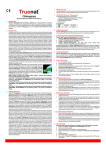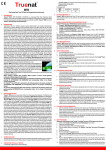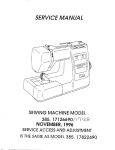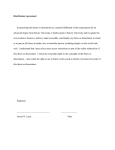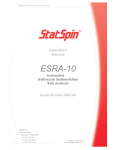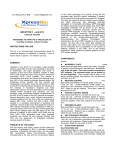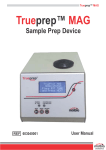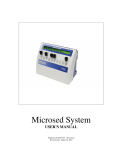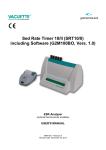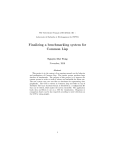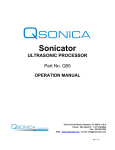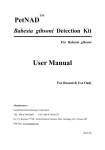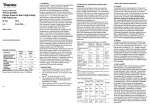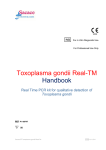Download Malaria Pf - Molbio Diagnostics
Transcript
5. Malaria Pf Chip-based Real Time PCR test for Plasmodium falciparum 1. 2. 3. 4. INTENDED USE Truenat™ Malaria Pf (REF 601120005 / 601120020) is a chip-based Real Time Polymerase Chain Reaction (qPCR) test for the quantitative detection and diagnosis of Plasmodium falciparum (Pf) in human blood specimen and aids in the diagnosis of infection with Malaria caused by Plasmodium falciparum (Pf). Truenat™ Malaria Pf runs on the Truelab™ Uno Real Time micro PCR Analyzer. INTRODUCTION Falciparum malaria is a life threatening disease caused by the protozoan parasite, Plasmodium falciparum, which is transmitted via the bite of an infected female Anopheles mosquito. In the human body, the parasites multiply in the liver, and then infect red blood cells. Plasmodium falciparum is known to cause the most dangerous malignant malaria which has the highest rate of complications and mortality. Early and accurate diagnosis of Falciparum malaria is necessary to initiate appropriate treatment, check transmission of the disease and prevent death. Microscopic examination of stained blood smears is still considered as the “gold standard” for detection of malaria parasitemia. However in comparison to PCR methods, these are reported to be only 80-90% sensitive. Nested PCR and real time PCR present higher sensitivity and specificity to malaria diagnosis compared to light microscopy. However PCR or Real Time PCR tests have so far been restricted to centralized reference laboratories as they require skilled manpower and elaborate infrastructure. Also the turnaround time for results could take a few days. The Truelab™ Real Time micro PCR System enables decentralization and near patient diagnosis of P. falciparum malaria by making real time PCR technology rapid, simple, robust and user friendly and offering “sample to result” capability even at resource limited settings. This is achieved through a combination of lightweight, portable, mains / battery operated Truelab™ Uno Real Time micro PCR Analyzer and TrueprepTM MAG Sample Prep Device and room temperature stable Truenat™ chipbased Real Time PCR test and TrueprepTM MAG Sample Prep kits so that even the peripheral laboratories with minimal infrastructure and minimally trained technician can easily perform these tests routinely in their facilities and report PCR results in less than an hour. Moreover, with these devices PCR testing can also be initiated in the field level, on site. Truenat™ Malaria Pf is a disposable, room temperature stable, chip-based Real Time PCR test with dried down PCR reagents for performing Real Time PCR test for detection and diagnosis of Plasmodium falciparum and runs on the Truelab™ Uno Real Time micro PCR Analyzer. It requires only six (6) µL of purified DNA to be added to the reaction well for the analysis. The intelligent chip also carries test and batch related information including standard values for quantitation. The Truenat™ Malaria Pf chip-based Real Time PCR test also stores information of used test to prevent any accidental re-use of the test. NOTE : Truelab™ / Truelab™ Uno / Trueprep™ MAG / Truepet™ / Truenat™ are all registered trademarks of Molbio Diagnostics (P) Limited. The Truelab™ Real Time micro PCR Analyzer is protected by the following patents and patents pending: IN 2313/CHE/2007, WO 2009/047804 and corresponding claims of any foreign counterpart(s) thereof. The Truenat™ micro PCR chip is protected by the following patents and patents pending: IN 2312/CHE/2007, WO 2009/047805 and corresponding claims of any foreign counterpart(s) thereof. The Truenat™ Malaria Pf test is protected by the following patents and patents pending: IN 421/CHE/2009, WO 2010/097803 and corresponding claims of any foreign counterpart(s) thereof. PRINCIPLE OF THE TEST Truenat™ Malaria Pf works on the principle of Real Time Polymerase Chain Reaction. The DNA from the patient blood sample is first extracted using Trueprep™ MAG Sample Prep device and Trueprep™ MAG Blood Sample Prep Kit. Six (6) µL of the purified DNA is then dispensed into the reaction well of the Truenat™ Malaria Pf chip-based Real Time PCR test. The Truenat™ Malaria Pf chip-based Real Time PCR test is then inserted in the Truelab™ Uno Real Time micro PCR Analyzer where thermal cycling takes place. A positive amplification causes the dual labeled fluorescent probe in the Truenat™ Malaria Pf chip-based Real Time PCR test to release the fluorophore in an exponential manner which is then captured by the built-in opto-electronic sensor and displayed as amplification curve on the analyzer screen, on a real time basis during the test run. The Cycle threshold (Ct) is defined as the number of amplification cycles required for the fluorescent signal to cross the threshold (i.e. exceed the background signal). Ct levels are inversely proportional to the amount of target nucleic acid in the sample. (i.e. the lower the Ct level the greater is the amount of target nucleic acid in the sample). Ct value is linearly correlated with the amount of target DNA present in the sample, enabling quantitative estimation of the analyte. Standard values for every batch are preset in the Truenat™ Malaria Pf chip-based Real Time PCR test and the analyzer automatically compares these with the Ct value of the test sample to provide a quantitative result. In the case of negative samples, amplification does not occur and a horizontal amplification curve is displayed on the screen during the test run. At the end of the test run, Falciparum “DETECTED” or “NOT DETECTED” result is displayed and in positive cases, Ct values and parasites per microlitre (P/µL) is also displayed on the screen. Based on the Ct of the Internal Positive Control (IPC), the validity of the test run is also displayed. The IPC is a full process control that undergoes all the processes the specimen undergoes from extraction to amplification thereby validating the test run from sample to result. Absence of or shift of IPC Ct beyond a pre-set range in case of negative samples invalidates the test run. While IPC will co-amplify in most positive cases also, in some specimen having a high target load, the IPC may not amplify, however the test run is still considered valid. The results can be printed via Bluetooth using the Truelab™ micro PCR printer or transferred to the lab computer/or any remote computer via Wifi network or GPRS network. Upto 5000 test results can be stored on the analyzer for future recall and reference. TARGET SELECTION The target sequence for this kit has been taken from the erythrocyte binding protein (EBP) gene which is expressed on the surface of the merozoites. EBP is involved in the parasite’s invasion of the red blood cells (RBC) by pathways that are specific to Plasmodium falciparum. The region selected is specific for P. falciparum. CONTENTS OF THE Truenat™ Malaria Pf KIT A. Individually sealed pouches, each containing a 1. Truenat™ Malaria Pf micro PCR chip. 2. DNase & RNase free pipette tip. 3. Desiccant pouch. B. Package Insert. REF 601020005 601020020 5T 20 T 6. STORAGE AND STABILITY Truenat™ Malaria Pf is stable for one year from the date of manufacture if stored between 2-30oC. It is also stable for upto three (3) months at temperatures up to 40° C. Avoid exposure to light. 7. MATERIALS REQUIRED BUT NOT PROVIDED WITH THE KIT Truelab™ Real Time micro PCR Workstation (REF 603010001) consisting of 1. Trueprep™ MAG Sample Prep Device (REF 603040001). 2. Truelab™ Uno Real Time micro PCR Analyzer (REF 603020001). 3. Truelab™ micro PCR Printer (REF 603050001). 4. Truepet™ Precision Micropipettes - 6µL, 50µL, 100µL, 500µL, 1000µL. (REF 604010006 / 604020050 / 604030100 / 604040500 / 604051000). Also required additionally are: TrueprepTM MAG Blood Sample Prep Kit (REF 609100050), Truenat™ Universal Control Kit (REF 601100008), DNase and RNase-free pipette tips (2 - 200µL / 200 1000µL microtips) with filter barrier, which may also be procured from Molbio (REF 604072200 / REF 604062010 respectively), Powder free disposable gloves, waste disposal container with lid. 8. SPECIMEN PREPARATION Truenat™ Malaria Pf requires purified nucleic acids from blood specimen that are extracted using the TrueprepTM MAG Sample Prep Device and TrueprepTM MAG Blood Sample Prep Kit (Refer to the User Manual of TrueprepTM MAG Sample Prep Device and the package insert of TrueprepTM MAG Blood Sample Prep Kit for details). 9. SAFETY PRECAUTIONS 1. For in vitro diagnostic use only. 2. Bring all reagents and specimen to room temperature (20 - 30o C) before use. 3. Do not use kit beyond expiry date. 4. Carefully read the User Manuals and package inserts of all the components of the Truelab™ Real Time micro PCR System before use. 5. All materials of human origin should be handled as though potentially infectious. 6. Do not pipette any material by mouth. 7. Do not eat, drink, smoke, apply cosmetics or handle contact lenses in the area where testing is done. 8. Use protective clothing and wear disposable gloves when handling samples and while performing sample extraction. 10. PROCEDURAL PRECAUTIONS 1. Check all packages before using the kit. Damage to the packaging does not prevent the contents of the kit from being used. However, if the outer packaging is damaged the user must confirm that individual components of the kit are intact before using them. 2. Do not perform the test in the presence of reactive vapours (e.g., from sodium hypochlorite, acids, alkalis or aldehydes) or dust. 3. While retrieving the Truenat™ Malaria Pf chip-based Real Time PCR test and the DNase & RNase free pipette tip from the pouch, ensure that neither bare hands nor gloves that have been used for previous tests run are used. 11. PROCEDURAL LIMITATIONS 1. Optimal performance of this test requires appropriate specimen collection, handling, storage and transport to the test site. 2. Though very rare, mutations within the highly conserved regions of the target genome where the Truenat™ assay primers and/or probe bind may result in the under-quantitation of or a failure to detect the presence of the concerned pathogen. 3. The instruments and assay procedures are designed to minimize the risk of contamination by PCR amplification products. However, it is essential to follow good laboratory practices and ensure careful adherence to the procedures specified in this package insert for avoiding nucleic acid contamination from previous amplifications, positive controls, or specimens. 4. A specimen for which the Truenat™ assay reports “Not Detected” cannot be concluded to be negative for the concerned pathogen. As with any diagnostic test, results from the Truenat™ assay should be interpreted in the context of other clinical and laboratory findings. 12. CLEANING AND DECONTAMINATION 1. Spills of potentially infectious material should be cleaned up immediately with absorbent paper tissue and the contaminated area should be decontaminated with disinfectants such as 0.5% freshly prepared sodium hypochlorite (10 times dilution of 5% sodium hypochlorite (household bleach) before continuing work. 2. Sodium hypochlorite should not be used on an acid-containing spill unless the spill-area is wiped dry first. Materials used to clean spills, including gloves, should be disposed off as potentially biohazardous waste e.g. in a biohazard waste container. 13. TEST PROCEDURE (Please also refer Section 4 in the Truelab™ Uno Real Time micro PCR Analyzer user manual) 1. Switch on the Truelab™ Uno Real Time micro PCR Analyzer touch screen. 2. Select user and enter password. 3. Select the test profile for “MALARIA Pf” on the Analyzer screen. 4. Enter the patient details as prompted in the Truelab™ Uno Real Time micro PCR Analyzer screen. 5. Press “Start Reaction”. Device will prompt as "Please load sample". 6. Press the eject button to open the chip tray. 7. Open a pouch of Truenat™ Malaria Pf and retrieve the micro PCR chip. 8. Label the chip with the patient ID using a marker pen at the space provided on the back side of the chip. 9. Place the Truenat™ Malaria Pf chip-based Real Time PCR test on the chip tray without touching the white reaction well. The reaction well should be facing up and away from the Analyzer. Gently press the chip to ensure that it is seated in the chip tray properly. 14. RESULTS & INTERPRETATIONS Two amplification curves are displayed on the Truelab™ Uno Real Time micro PCR Analyzer screen to indicate the progress of the test. Both the target and the internal positive control (IPC)* curves will take a steep, exponential path when the fluorescence crosses the threshold value in case of positive samples. The Ct will depend on the number of parasite genomes in the sample. The target curve will remain horizontal throughout the test duration and the IPC curve will take an exponential path in case of negative samples. In case the IPC curve remains horizontal in a negative sample, the test is considered as Invalid. At the end of the test run, the results screen will display “DETECTED” for Positive result or “NOT DETECTED” for Negative result. The result screen would also display the Ct value and the parasites per µL (P/µL) for positive specimen. The result screen also displays the validity of the test run as “VALID” or “INVALID”. Invalid samples have to be repeated with fresh specimen from the sample preparation stage. *While IPC will co-amplify in most positive cases also, in some specimen having a high target load, the IPC may not amplify, however the test run is still considered valid. 15. QUALITY CONTROL PROCEDURES To ensure that the Truelab™ Uno Real Time micro PCR Analyzer is working accurately, run positive and negative controls from time to time. The Truenat™ Universal Control Kit containing Positive Control and Negative Control must be ordered separately. It is advisable to run controls under the following circumstances: ? Whenever a new shipment of test kits is received. ? When opening a new test kit lot. ? If the temperature of the storage area falls outside of 2-30o C. ? By each new user prior to performing testing on clinical specimen. 16. DISPOSAL AND DESTRUCTION 1. Submerge the used Truenat™ Malaria Pf chip-based Real Time PCR test in freshly prepared 1% sodium hypochlorite solution for 20 minutes before disposal as per the standard medical waste disposal guidelines. 2. Disinfect the solutions and/or solid waste containing biological samples before discarding them according to local regulations. 3. Samples and reagents of human and animal origin, as well as contaminated materials, disposables, neutralized acids and other waste materials must be discarded according to local regulations after decontamination by immersion in a freshly prepared 0.5% of sodium hypochlorite for 30 minutes (1 volume of 5% sodium hypochlorite for 10 volumes of contaminated fluid or water). 4. Do not autoclave materials or solutions containing sodium hypochlorite. 5. Chemicals should be handled in accordance with Good Laboratory Practice and disposed off according to the local regulations. 17. SPECIFIC PERFORMANCE CHARACTERISTICS ASSAY RANGE Plasmids carrying cloned PCR amplicons were used as template DNA. The samples were quantified by UV spectrophotometry to determine the copy number/microlitre. The plasmids were serially diluted and tested using Truenat Malaria chips to obtain Ct values which were plotted against the plasmid concentration per reaction to determine the range of the assay. The assay was found to have a broad linear dynamic range (over 7 orders of magnitude). The Truenat™ Malaria Pf test was able to detect as low as 2 parasites per µL equivalent of blood. CLINICAL SENSITIVITY / CLINICAL SPECIFICITY: Truenat™ Malaria Pf was tested against a nested PCR protocol (according to SOP: 5.8 of WHO; Methods Manual for Product Testing of Malaria Rapid Diagnostic Tests, Version 2, 2009 ) and clinical sensitivity and specificity were both found to be 100%. Truenat™ Malaria Pf was tested with 50 archived Pf positive samples obtained from National Institute of Malaria Research (NIMR), Bangalore and 50 Pf negative samples. The WHO Nested PCR protocol was run in parallel to confirm the status of the samples. All the 50 Pf samples were detected as positive and the 50 Pf negative samples were negative respectively by both Truenat™ Malaria Pf and the WHO nested PCR protocol. REPRODUCIBILITY AND PRECISION : Truenat™ Malaria Pf kit was tested for reproducibility and precision between users, analyzers and reagent lots. Pf DNA was extracted from a high titre clinical specimen and serially diluted for this study. The same sample panel was provided to 3 users, who ran it on 3 different Truelab™ micro PCR analyzers with 3 different lots of Truenat™ Malaria Pf. The tests were run in triplicates. High inter-user, inter-analyzer and inter-lot reproducibility was observed (average standard deviation = 0.26 Ct) and no significant difference was noted in the Ct values obtained from different users or analyzers or reagent lots. METHOD CORRELATION Validation at National Institute of Malarial Research (NIMR)-Bangalore: Results of Truenat™ Malaria Pf chip-based Real Time PCR test from 119 archived clinical specimens were correlated with microscopy and a commercially available rapid diagnostic test (RDT). Relative clinical sensitivity, normalized with the Truelab™ results as 100%, is tabulated below. Summary of validation study using NIMR samples: Parasite species Plasmodium falciparum (Pf) n=119 Truenat™ Malaria Pf Microscopy RDT 100% 78.57% 77.14% Truenat™ Malaria Pf reported more number of positives than the other methods. INTERFERENCE Effect of interferences of elevated serum parameters such as lipid, cholesterol and triglycerides were evaluated in this study. Specimen (total 10 samples) showing higher level of serum parameters were spiked with known amount of P. falciparum positive samples. These spiked samples were tested using Truenat™ Malaria Pf. The Ct values obtained were found not to be significantly impacted (Ct average = 27.93; standard deviation = 1.7, variance = 2.89) by the presence of elevated biochemical parameters as described above. Carry Over Effect: To determine whether the Truenat™ Malaria Pf microchip PCR assay showed any signs of carryover of PCR products between runs, alternating runs of positive Pf high titre samples and negatives samples were performed in triplicates. 10 positives samples and 10 negatives samples were used for the study. Results of carry-over evaluation are below: Sr. No. Sample I.D. Ct Pf 1 Ct Pf 2 Ct Pf 3 Average STDEV 1 Positive 23.5 23 23.2 23.23 0.25 2 Negative - - - - - 3 Positive 21.8 22 22.3 22.03 0.25 4 Negative - - - - - 5 6 Positive Negative 22.1 - 22.4 - 22.5 - 22.33 - 0.21 0.15 7 Positive 23 23.1 23.3 23.13 8 Negative - - - - - 9 Positive 23.1 23.4 23.5 23.33 0.21 10 Negative - - - - - 11 12 Positive Negative 21.9 - 22 - 22.2 - 22.03 - 0.15 0.80 13 Positive 21.6 21.8 22 21.80 14 Negative - - - - - 15 16 17 18 19 20 Positive Negative Positive Negative Positive Negative 21.4 23.2 22.1 - 21.6 23.4 22.3 - 21.5 23.6 22.6 - 21.50 23.40 22.33 - 0.10 0.20 0.25 - All the positive samples were accurately detected and all negative samples were undetected indicating absence of carryover of PCR products between runs using the Truenat™ Malaria Pf chipbased Real Time PCR test. 18. REFERENCES 1. Rich, S. M. et al (2009) "The origin of malignant malaria". Proceedings of the National Academy of Sciences 106(35): 14902-14907. 2. Perlmann, P. et. al. (2000). "Malaria blood-stage infection and its control by the immune system". Folia biologica 46 (6): 210-8. 3. Marchand RP, et. al. (2011) Co-infections of Plasmodium knowlesi, P. falciparum, and P. vivax among Humans and Anopheles Mosquitoes, Southern Vietnam. Emerg Infect Dis. Jul 2011; 17(7):1232-9. 4. Moody A. (2002) Rapid diagnostic tests for malaria parasites. Clin Microbiol Rev 2002; 15:66-78. 5. Andrade et. al. (2010) .Towards a precise test for malaria diagnosis in the Brazilian Amazon: comparison among field microscopy, a rapid diagnostic test, nested PCR, and a computational expert system based on artificial neural networks. Malaria Journal 2010,9: 117. 6. Khairnar K, et al. (2009) Multiplex real-time quantitative PCR, microscopy and rapid diagnostic immuno-chromatographic tests for the detection of Plasmodium spp: performance, limit of detection analysis and quality assurance. Malar J 2009, 8:284. 7. Shokoples S.E. et al. (2009).Multiplexed real-time PCR assay for discrimination of Plasmodium species with improved sensitivity for mixed infections. J Clin Microbiol 2009, 47:975-980. 8. WHO-FIND-CDC Malaria RDT Product Testing Methods Manual (Version 1)- 05/2008. 9. Adams JH et al. (1992) A family of erythrocyte binding proteins of malaria parasites. Proc Natl Acad Sci USA 89, 7085-7089. Pascal Michon et. al (2002). Evolutionary Relationships of Conserved Cysteine-Rich Motifs in Adhesive Molecules of Malaria Parasites. SYMBOL KEYS: Consult Instructions for use Date of Manufacture IVD In vitro Diagnostic Medical Device Date of Expiry LOT 0 30 C Manufacturer 0 2C Batch Number / Lot Number Store at 2-300C Contains sufficient for <n> tests REF 2 Catalogue Number For single use only Manufactured by: Molbio Diagnostics Pvt. Ltd. M 46-47, Phase III B, Verna Industrial Estate, Verna, Goa - 403 722, India. E-mail: [email protected] TNMAL/0413/VER-01 10. Using the filter barrier tip provided in the pouch, pipette six (6) µL of the purified DNA from the Elute Collection Tube into the centre of the white reaction well. Take care not to scratch the internal well surface and not to spill elute on the outside of the well. 11. Slide the chip tray containing the Truenat™ Malaria Pf chip based Real Time PCR test loaded with the sample, into the Truelab™ Uno Real Time micro PCR Analyzer. 12. Press the power button on the Analyzer to turn it on. The green LED should glow. 13. Press Done on the “Please Load Sample” Alert message. 14. At the end of the test, observe the optical plot for any irregularities (Refer to the Truelab™ Uno Real Time micro PCR Analyzer manual). 15. Read the result from the screen. 16. Press the power button on the Analyzer to turn it off. The green LED should stop glowing. 17. Take out theTruenat™ Malaria Pf chip-based Real Time PCR test at end of the test and dispose it off as per the section on “Disposal and Destruction” (Section 16). 18. Turn on Truelab™ micro PCR printer and select print on the screen for printing out hard copy of the results. Test results are automatically stored and can be retrieved any time later. (Refer to the Truelab™ Uno Real Time micro PCR Analyzer manual). 19. Switch off the Truelab™ Uno Real Time micro PCR Analyzer touch screen.


